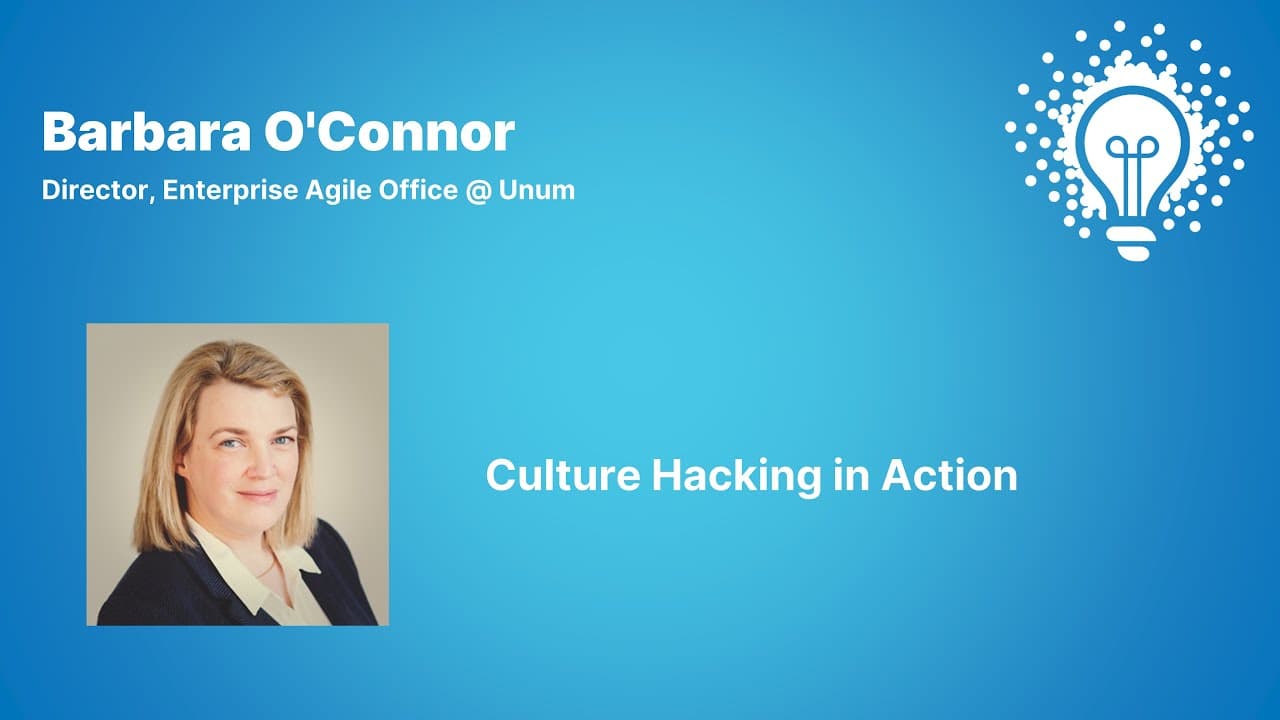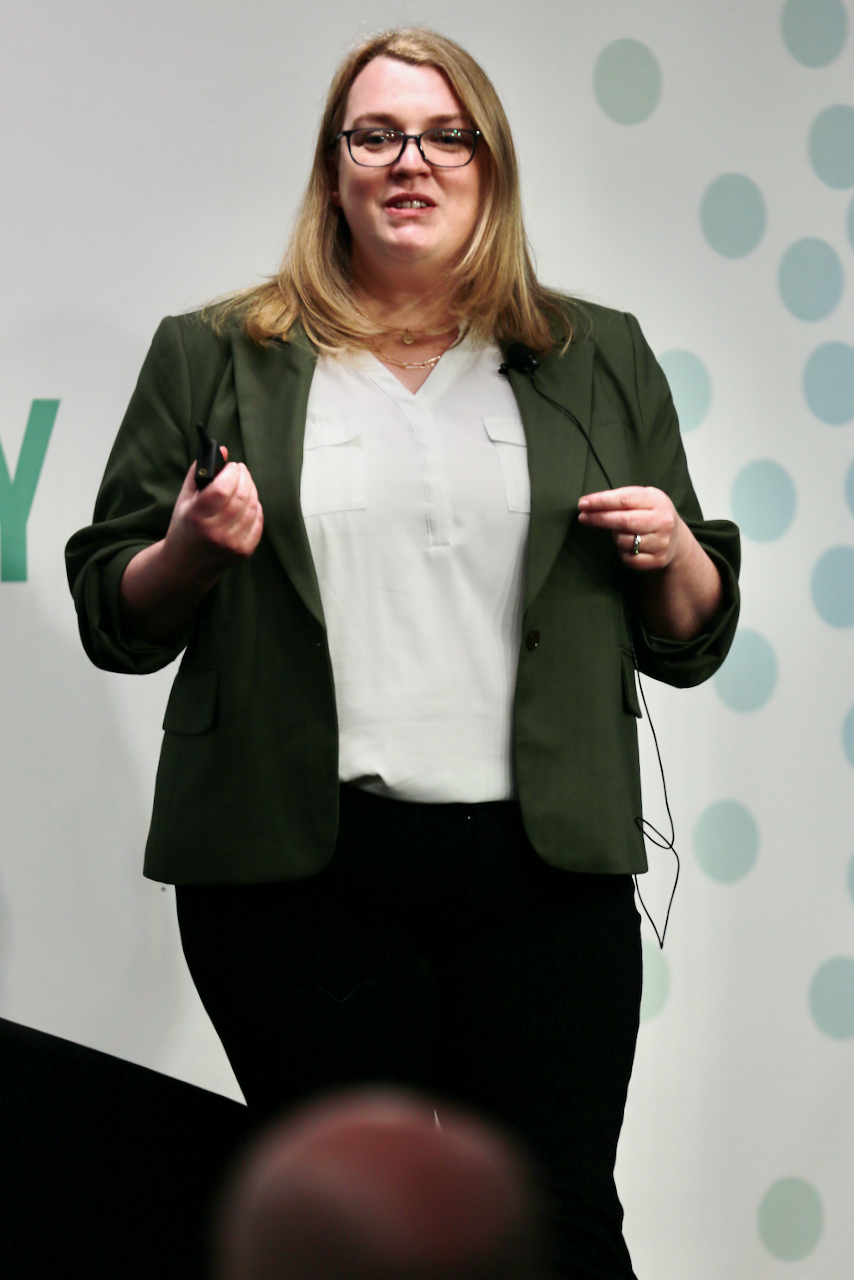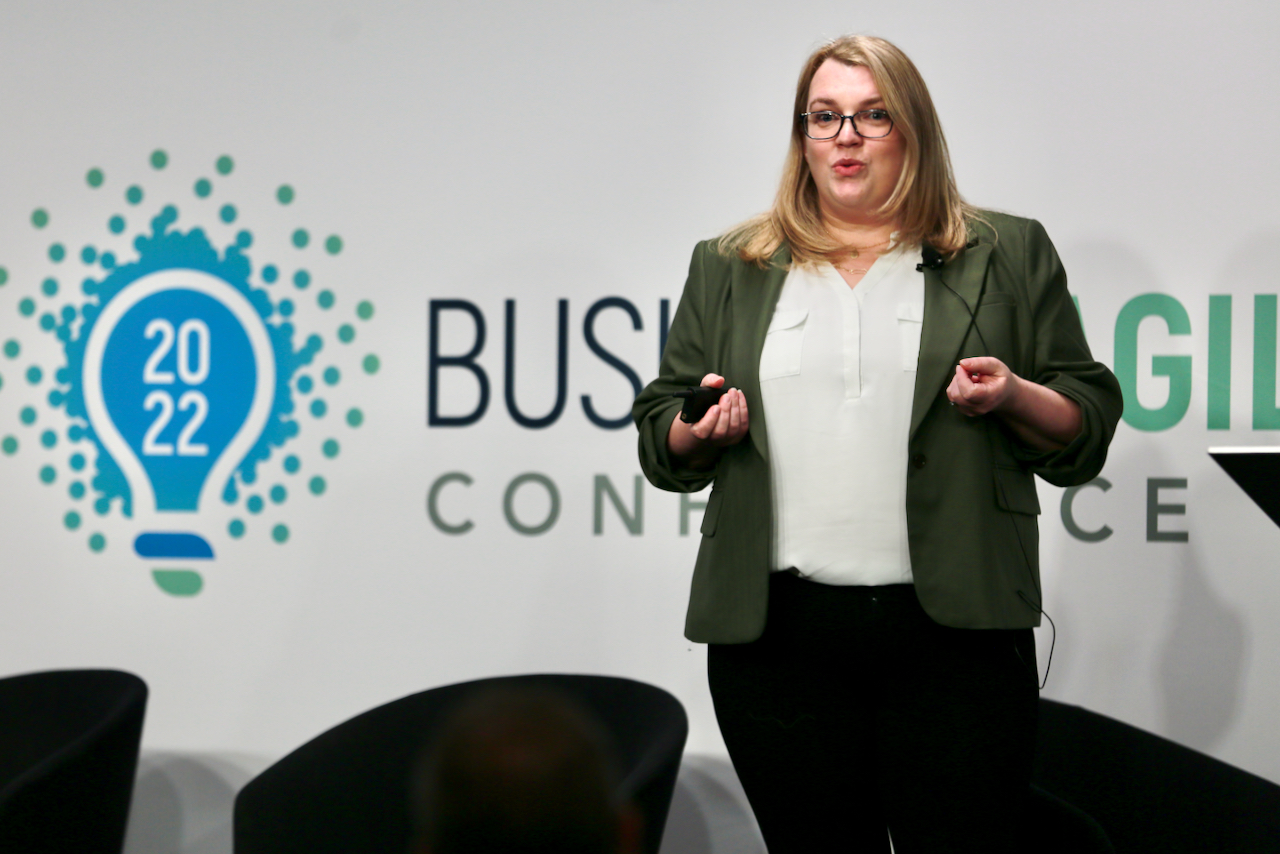Today, I'm here to talk about culture hacking in action. We are proud culture hackers at the Unum Group, which is an insurance company. It's over 170 years old. But really, really proud of our journey, especially over the last five years. So what do I do all day or what does my day look like? Honestly, my day looks like 90% culture related things with kind of a side serving of processes, practices, mechanics, because that's part of our life, too. Okay. Does the clicker love me yet? No, it doesn't love me. I don't know. Okay, there we go. So why is culture hacking even a thing? How did this come onto our radar? It came on our radar, because those meetings to discuss culture, you know, the ones I'm talking about, the engagement results are out, and the chart is here, and we got a survey. We're not actually talking to people, but we're called into those meetings. And a couple of things were happening in those meetings. I call it star-gazing and navel-gazing. I'm looking out the window. I'm looking at my feet. I'm doing everything except engaging.
So sitting back in my role and being an observer, or maybe we can call them professional observers, those coach people. What was going on? What were we saying and what were the words we were using? So during the star-gazing and navel-gazing hours of my life, we realized that we weren't great at talking about culture. We had, on one hand, these very generic statements like, we want trust, we want engagement. Great, that's not very actionable, or restating a problem, we don't have trust— still not very actionable. Then what would happen is we would have these great ideas, let's get 100 people in a room and brainstorm. Now we have 1,000 ideas, which have merit in their own right, but they are incoherent. So I've gone from, I don't know what to do with that to I'm drowning in that. I can't navigate that, and people disconnect, because I'm in sensory overload. I'm sensory overloaded, and I have a lot of work to do. We have timelines and project status reports at 6:00AM, eastern standard in our case. Exactly.
So what are we going to do about it? We had to do something, because our people needed us to do something. Everybody comes to work to do a good job. Everybody comes to work to contribute. Everybody wants to be helpful. Everybody wants to be a good colleague. But we weren't serving them in a way that could make it tactical and actionable, so we had to do something about this whole culture conversation, because star-gazing is interesting and all, but that's not the day job.
Okay... Still does not like me. Angel, helped me out back there. The team here are just fantastic. So we took a look at our culture, and our culture is fundamentally mechanics and dynamics. Somewhere along the line, we realized, why are we treating them separately?—because we were. We talked about people and we obsessively focused on people and how are you feeling. And then we would come over and we would optimize these processes, these very mechanical things. But they're not separate things. This is where we started to use the phrase, we need to de-industrialize our thinking. We had come up through education systems that talked about industrializing and breaking things down, and optimizing these individual parts. And that's just not how humans interact with the world. We had to go about the business of de-industrialising how we talked about it, and that meant little pieces of mechanics and dynamics. Because people manifest their behavior through words and actions, and things that they're doing. We can't mind read. Maybe some people can. If you can—I'd like to talk to you— but I can't mind read. So what's going on in your head? You need to use something tangible, so that I can communicate with you. So we're going to advance one more, if we can. Great. I'm going to talk a little bit about mechanics. Take a look at these three statements I've put up here. In the room, if anybody wants to put up their hand or nod your head, do any of these look familiar? Have you ever spotted any of these mechanics? Okay, yeah, there's some hands up and some nodding.
All right. I cannot take credit for these ones. These are courtesy of the CIA, Field Manual for Simple Sabotage published in 1944, declassified— I promise, declassified in 2008. Interesting stuff. Seriously, a good read. They had a field manual for sabotage of companies. They figured out 80 odd years ago how do you bring a company to its knees? How do you slow down a company to become ineffective, inefficient, grinded to a halt? Here's what you do. You take some activities and you basically amplify them. There's nothing wrong with a committee. Everything by committee will slow you down. There's nothing wrong with a good policy— I like them myselves— they have their places. Do I need five hours to wordsmith a single email? Really hope not. I really hope people would say, "Barbara could have used a better word, but, you know, five hours or endless wordsmithing."
If 85 years ago, people figured out, here's how you bring a company to its knees. I'm going to ask this group, have our cultures fallen into a self-sabotage cycle? Things that seemed like a good idea, that's great, and we had some success. Fantastic, let's do more of it. The let's do more of it, it came from a place of positive intent, but it started to hurt us, and it hurt us in a way that we couldn't easily see it. If this happened, so if at this point, you're saying to yourselves, I've seen the star-gazers and naval-gazers—check— and I've seen some of these mechanics that Barbara is talking about, great. Do I have the ability to self-rescue? Do I have a field manual for self-rescue from a culture that just took a left turn a couple of miles back, and we haven't really found our way back onto the road? And do we have a self-rescue mechanism that we can deploy at scale? Because what we needed is we needed scale. I don't own my culture. I am part of a culture, so I don't own it, and I can't install it. I certainly can't control it, I wouldn't want to. So I need something to help us navigate self-rescue. It needs to be low tech. It needs to be relatable. It needs to be able to be recalled at scale by people, who don't spend a lot of time talking about this culture thing. That's what consultancy people do or people in business magazines do. I'm talking about 2,000 people out in an organization.
So, this brings me to my organization. I personally have never walked up and shook hands with the building. I never had coffee with the HR policy, but I have walked inside the doors of our company, Lots of companies, you know that vibe you get when you walk into a coffee shop or you walk into a legal firm, or something like that, you get a vibe. I can't put my finger on it, but I feel the culture. That's what I'm talking about. I interact with cultures and people. And so, there's a pulse. You know when you walk into a room and you really get the vibe, or it might take you a little while to realize, yeah, this is my vibe. I kind of think I'm starting to sense this place. It doesn't mean it's a good or a bad, strong or weak culture, it just means that some cultures are a little spikier. We see that a lot with newer start-ups or those places going through a lot of disruption, or a lot of employee turnover. They're spiky. They're open to change. They're still trying to figure out who they are. Then in other cases, you have groups that are together for quite a long time, and they're strong, they're established cultures. So just recognizing what sort of vibe and pulse have I got here? Then we're starting to veer back into my naval-gazing, star-gazing conversation here. This is what people typically would say to me, "Hey, Barbara, we need a culture of diversity. We need a culture of trust, empathy" et cetera. Insert the buzzword that you face in your own workplaces. I look at them and I plot them out going, "Okay, really good. Tell me more, tell me more." And that's interesting. So I may prompt to say, "Well, tell me some of the other things that are here, other things that how would I know that about your culture?"
So we start to get these things here called recruitment processes, training programs. We have got distinctly tangible and intangible factors influencing our culture. So here's the thing. I can work with the tangibles and hope that they have an impact on the intangibles, but when we focus to the top and the intangible, we burn up a ton of our capacity— our mental energy— on something that we can't turn the needle on, because we've left all these tangible things in place that lock us into a way of behaving. The first thing about our culture hacking is, simply this, is do you have a way to visualize and recall a system in words that are relevant to you, and how quickly can you do that? And do I recognize all the words that are up here on screen? Hopefully we do. Again, I've got some nodding in the room. Nobody's walked out yet. Excellent.
The last word that's up there is this culture word, and that culture word is kind of squashy, it's another one of those. So I'm going to ask you, when you think about culture, I'm going to ask you to change that word to choices. Your culture isn't something passive that you have no say in. You are your culture, but it is your choice. It's not passive. You make a choice about how you respond, how you speak to people. Do you come from a place of positive intent, or are you feeling kind of stressed out, and I don't have time for all that positive intent business. Give me my project report. But there are choices. So whenever you see these documents that come through your mailbox that have the word culture, fun exercise that we often take is we do a search and replace. We change out the word choice for culture, and we see how people respond in a different way, and they do, because a choice feels like something I can participate in. A culture feels like something that happens to me. So I took the time. You should be grateful, because my handwriting is atrocious. But these are very much the notebooks that you'll find myself and a large group of people—our volunteers— walk around our organization with. Phone rings, "Hey, Barbara, do you have a minute?" Sure I do. "I'm really struggling with this thing." Okay, tell me more about this thing. And they're like, "We got this feedback from our engagement surveys and I'm worried about diversity. I'm like, "Okay, let's talk about that."
So the choice is what's at heart, my choice is, I want to improve diversity, and it'll mature, it'll evolve, it'll refine. But then we start talking about, is diversity really the impact? Are you looking for representation or are you looking to understand why the people that you do have are not engaging? Just like, if you're in straight up refinement in an agile scrum team, you start refining that choice— what would different look like? Then you go, okay, I can't really impact inclusivity, but I can impact representation. So let me go look—maybe at the bottom— the levers that we would have, what's our training policies, what's our recruitment policies? There are things that we can influence.
With that in mind, you take a look at impact, what are the levers that you can use, and then you come along as what is the choice that I want to make? The choice that people phone you up are really struggling with is rarely the choice that you settle on after the conversation. It kind of morphs and gets a little cleaner. So what we do at that point is we go, okay, you're starting to get an idea, so there's something about our recruitment policies that maybe we want to look at. So what exists out there? Number one, what choice do I want to alter? Next thing is, what tangible thing exists that I could potentially work with? Then we go to, if I take that thing and do something to it, can we get a different outcome? We have to remember this part. This is me on a call with an individual person, but this is just an idea.
Unless you put it in the hands of people, it will not execute, it's a pretty slide, it goes nowhere. Every idea and change has to go through the hands of people. If you've picked a lever that does not incorporate people, go back, do not pass go, do not proceed. I wanted to share with you our Q4 hackathon. We actually ran a hackathon, and I thought this would be fun to share with you. This is lots of text on it, because I just wanted to lift it. I didn't want to massage the message here. It was simply, we picked up a theme and our community voted, so it was MacGyver. What we were doing here, is we were essentially looking for a way to take a concept —a hackathon— which is very well accepted in our technology areas. Our technology areas, they would run hackathons all the time, so we changed it up a little bit. We said, what if you take a hackathon, but I'm not going to give you a problem, you're going to come and tell me what is it about how we work, our processes and practices that we need to modify? So you come to me. And this is some of the things that we got.
Lots of reading here. I won't drain the slide, but what we've got here is, we had a group that rewrote training materials, because they were not friendly for screen readers, and we had a number of new hires that needed screen reader technology. Just had passed us over. Something small, but it said a lot about equity and inclusion. We have a backlog management tool, but there were different sets of permissions, so they said, "You either trust us or you don't." And I said, "Okay, we trust you." So everybody got leveled to the same level of permission. If you're not trusted to be in a system, why are you here? So we leveled the permissions.
Our ways of working—community of practice. You are incentivized to change it. You are incentivized to come forward and actively come up with different ways of working. That was culturally to adjust the things that we do, where we manifest what we're doing. They're not passive. They don't happen to you. How we work is part of the full discussion. So you come to our community of practice that's increased from 30 to 200 every month, completely voluntary. It's run by a grouping of volunteers. That tells you a lot about our engagement that we have in the group. That's a hackathon, and that's how we took one of the challenges we were having, how do you keep things fresh? What can we take— we can take a hackathon and adjust it. And what are the outcomes that we're seeking to change— the choices that people would make. So here's my advice.
Don't make it too complicated. If you can't describe what you're trying to do in two sentences or less, it's really, really hard for people to follow your vision. It's really, really hard, so two sentences or less, and keep it simple. It's easier to go out with potentially 200 micro changes than one huge change. That feels scary to people. So don't make it too complicated. Just begin. How will you know? We're obsessed with measuring things as a culture. So how will you know? You'll know, by the choices. If you really want to look further, look at your engagement surveys, your comments. Of course, talk to people. That's a given. But look at your retention and your exit interviews, and don't just scan them and toss them, and then delete. Really take a look at what are the choices that we took that made that person take their choice. So a world obsessed by measurements, look at the choices that we're making.
On that note I'm going to thank you so much for your time. I encourage you all to give hacking your culture a try. It's not so scary, but it does have big returns.





